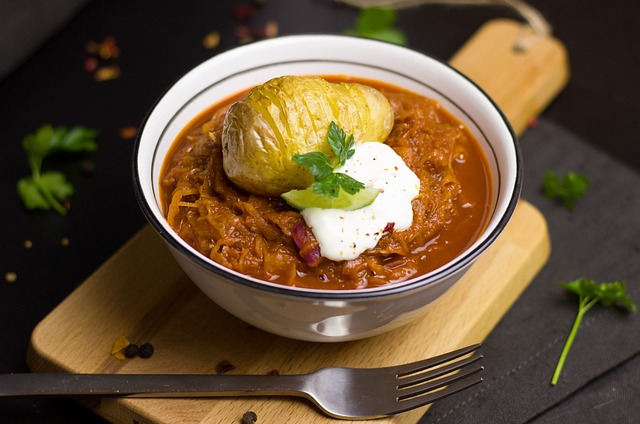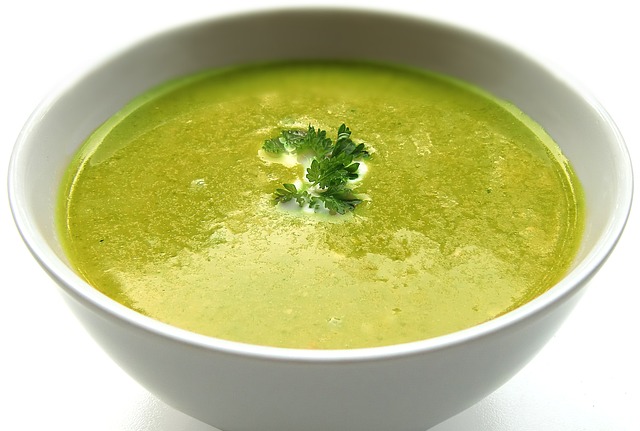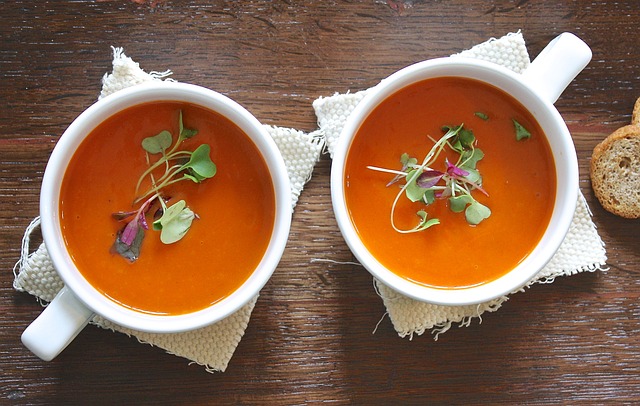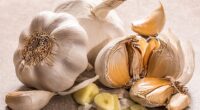Stew is a thick, hearty dish with larger ingredients, slow-cooked in a reduced liquid, while soup is thinner, often with smaller ingredients, and more liquid-based.
TL;DR Stew Vs. Soup
Stew, with its hearty and thick consistency, is a comforting dish that often features larger chunks of meat or vegetables slow-cooked to perfection. It’s perfect for colder days when you crave something filling and warming.
On the other hand, soup is a lighter option with a thinner broth base that allows flavors to meld together beautifully. It offers versatility in terms of ingredients and can be enjoyed as an appetizer or main course depending on its composition.
What is a Stew?

A stew is a hearty and flavorful dish consisting of large pieces of meat or vegetables, simmered slowly in a flavorful liquid or gravy until tender. Stews are known for their rich, thick consistency and deep, savory flavors.
Common ingredients in stews include beef, lamb, chicken, root vegetables, and legumes. Stews often incorporate seasonings, herbs, and spices to enhance taste.
The long, slow cooking process allows the ingredients to meld together, creating a cohesive and satisfying meal. Stews are enjoyed worldwide, with variations such as Irish stew, beef bourguignon, and goulash, each reflecting regional tastes and ingredients.
What is Soup?

Soup is a liquid-based dish made by simmering various ingredients like vegetables, meat, or legumes in a flavored broth or stock. It typically has a thinner consistency than stews, allowing it to be served as a warm, comforting, and often appetizing starter or main course.
Soups come in countless variations globally, from clear broths to creamy bisques, and can be seasoned with herbs, spices, or garnishes to enhance flavor.
Soups provide versatility for incorporating seasonal ingredients and are enjoyed for their nourishing qualities, diverse flavors, and ability to accommodate different dietary preferences and culinary traditions.
Stew Vs. Soup – Key differences
| Aspect | Stew | Soup |
|---|---|---|
| Consistency | Thick and hearty with a rich, dense broth. | Thin and often clear or lightly flavored. |
| Ingredients | Contains larger chunks of meat, vegetables, or legumes. | Contains smaller, finely chopped or sliced ingredients. |
| Cooking Time | Requires longer cooking times, often slow-cooked to tenderize ingredients. | Typically has shorter cooking times, making it quicker to prepare. |
| Broth/Stock Base | Uses a reduced, flavorful broth or stock that coats ingredients. | Features a more prominent and clear broth or stock. |
| Flavors and Seasoning | Known for deep, robust flavors with strong seasonings and herbs. | Generally lighter in flavor, allowing individual ingredients to shine. |
| Satiety | Hearty and filling, often served as a main course. | Usually served as a starter or lighter meal. |
| Variations | Includes dishes like beef stew, Irish stew, or goulash. | Offers a wide range of options, such as chicken noodle soup, tomato soup, and minestrone. |
| Garnishes | Less common for garnishes due to its substantial nature. | Often garnished with fresh herbs, croutons, or grated cheese. |
| Regional Specialties | Found in various global cuisines, each with unique regional variations. | Prevalent in diverse cuisines worldwide, adapting to local ingredients and tastes. |
Ingredients Used in Stew and Soup
Ingredients Commonly Used in Stew
- Meat: Beef, lamb, chicken, pork, or game meats are often used as the primary protein source.
- Vegetables: Potatoes, carrots, onions, celery, and root vegetables like turnips and parsnips are common additions.
- Legumes: Beans, lentils, and chickpeas are sometimes added for extra protein and texture.
- Broth/Stock: Beef, chicken, or vegetable broth or stock is used as a base to create the rich, flavorful gravy.
- Herbs and Spices: Bay leaves, thyme, rosemary, garlic, and black pepper are frequently used for seasoning.
- Liquid: Red or white wine, tomato paste, or water can be added to create the cooking liquid.
- Thickeners: Flour, cornstarch, or roux (butter and flour mixture) may be used to thicken the stew.
Ingredients Commonly Used in Soup
- Broth/Stock: Chicken, beef, vegetable, or seafood broth or stock forms the liquid base of the soup.
- Vegetables: Onions, carrots, celery, garlic, and leafy greens like spinach or kale are common soup vegetables.
- Protein: Chicken, beef, pork, seafood, or tofu may be included for added protein.
- Pasta/Rice: Noodles, rice, or grains like barley or quinoa are used to add substance.
- Herbs and Spices: Parsley, basil, thyme, oregano, and paprika are among the frequently used seasonings.
- Tomatoes: Tomato-based soups often include canned tomatoes, tomato paste, or fresh tomatoes.
- Legumes: Lentils, beans, or split peas are added to some soups for texture and nutrition.
- Dairy: Cream, milk, or yogurt can be used to create creamy soup variations.
- Garnishes: Fresh herbs, grated cheese, croutons, or a drizzle of olive oil are used as garnishes.
These lists provide a general overview of the ingredients typically found in stews and soups, but both dishes offer ample room for creativity and customization to suit various tastes and dietary needs.
Image Credits
Featured Image By – Aline Ponce from Pixabay
Image 1 By – Security from Pixabay
Image 2 By – Bernadette Wurzinger from Pixabay








